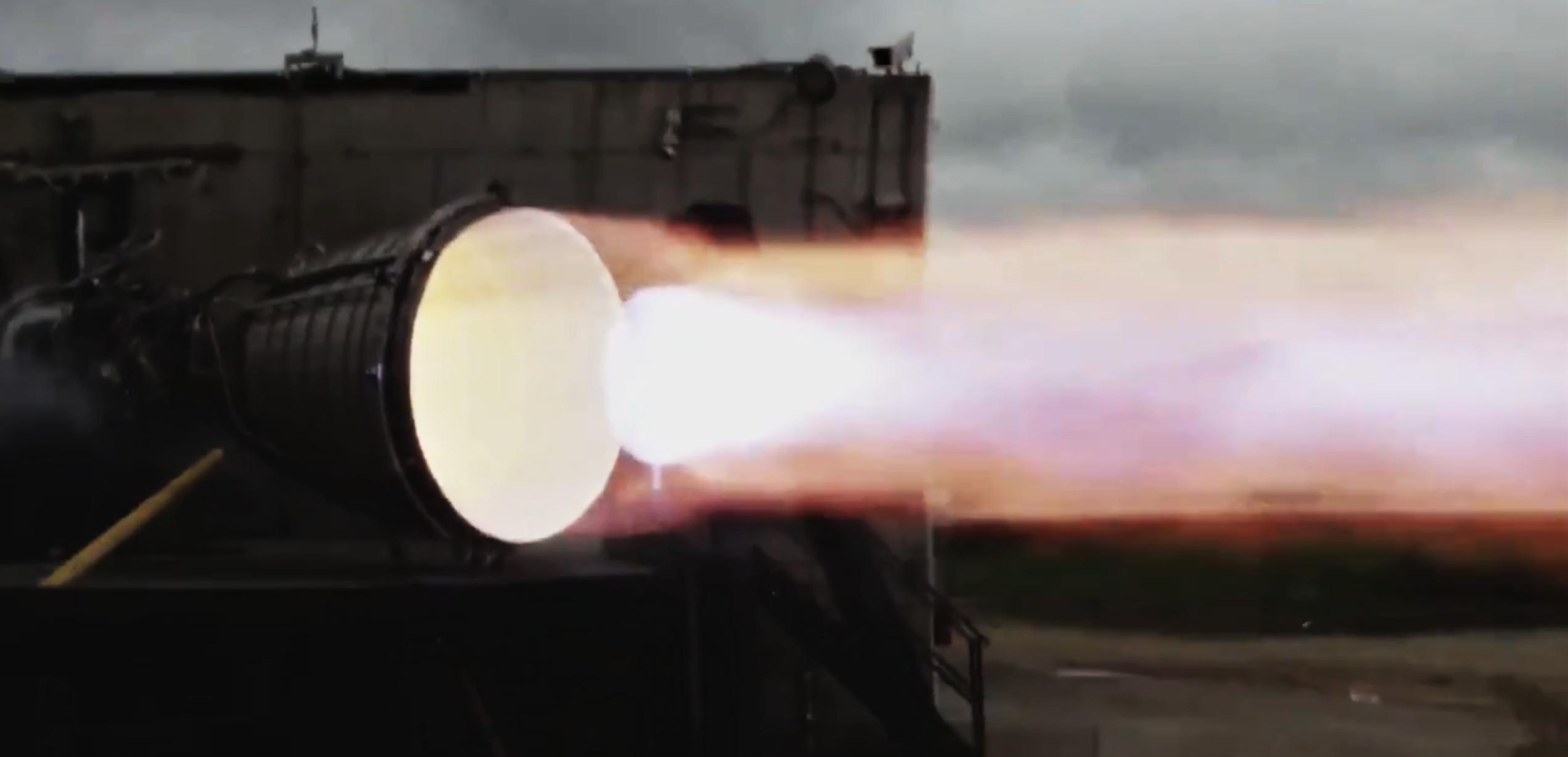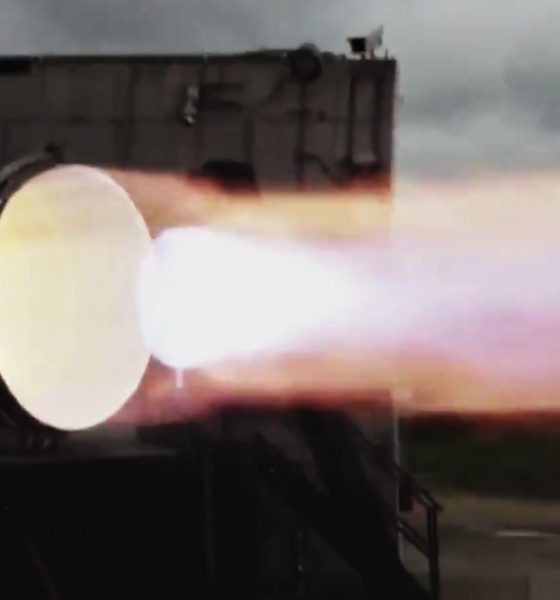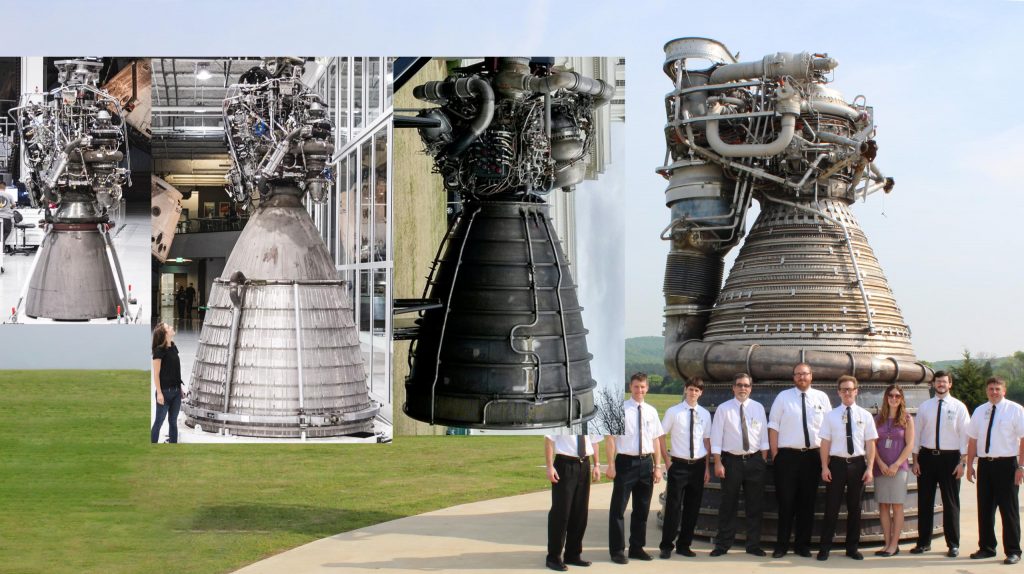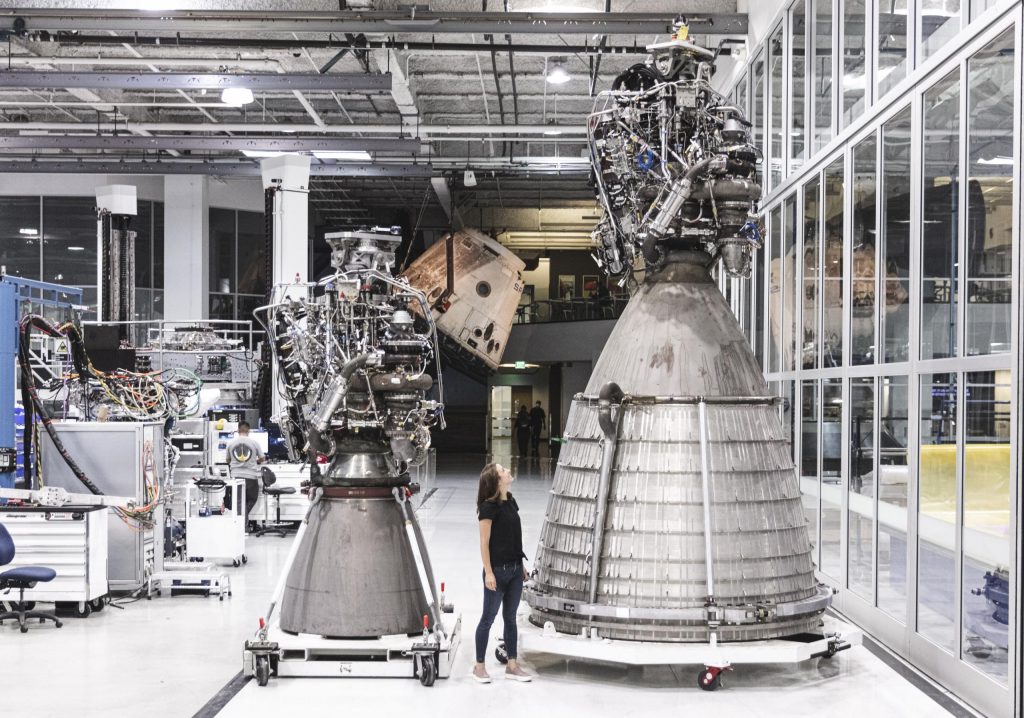

News
SpaceX’s first orbital Starship engine just breathed fire
Less than three weeks after shipping to Texas, SpaceX says that Starship’s first Raptor Vacuum engine has completed a “full duration test fire” on the march towards orbital test flights.
Known as Raptor Vacuum or RVac, the engine is almost entirely based off of its sea level-optimized cousin, taking all of the complex turbomachinery and combustion chambers that represent the bulk of a rocket engine. Things start to diverge below the throat of the combustion chamber (the narrow part of the central hourglass-like curve), where SpaceX has expanded Raptor’s existing bell nozzle by a factor of five or more.
SpaceX’s reusable Starship spacecraft will use a mix of three sea level Raptors and three Raptor Vacuum engines to give it the thrust it needs to reach orbit and ensure efficient operations both in atmosphere and vacuum.

In simple terms, a rocket engine can benefit from a vacuum-optimized nozzle because the added surface area (more or less) gives the extremely high-pressure gases exiting its combustion chamber even more footholds to push against. Rocket nozzles are at their most efficient when the engine’s exhaust gas finishes expanding to match ambient pressure at the exact moment it exits the bell. Logically, at sea level on Earth, the ambient air pressure is quite high, meaning that rocket exhaust doesn’t have to expand as much to equalize.

In the vacuum of space, however, exhaust gases must expand far more to reach the same pressure as its surroundings. For rocket propulsion, that extra expansion can be exploited to make a more efficient engine, squeezing extra energy out of the same propellant and in a perfect vacuum, the most efficient nozzle would technically be infinite. Engineering and physical infinities don’t exactly get along, unfortunately, so vacuum rocket engineers are forced to settle on a nozzle size at a scale that humans can feasibly manufacture.
In theory, Starship doesn’t need Raptor Vacuum engines to be a functioning orbital spacecraft and CEO Elon Musk himself floated a design with seven sea-level engines just two years ago. Since then, the SpaceX CEO revealed that Raptor was making such good progress that the company undid the removal of vacuum-optimized engines from Starship’s baseline design.

It’s unclear exactly what SpaceX means when it says that Raptor Vacuum SN1 completed a “full duration test fire.” For Starship, a full-duration orbital insertion burn – beginning immediately after Super Heavy booster separate – would likely be no shorter than five or six minutes. Even for SpaceX, going from shipping the very first engine (Raptor Vacuum) produced to a successful several-minute static fire in less than three weeks’ time would be an almost inconceivable feat of engineering. The feat would imply that SpaceX is already extremely comfortable with several-minute Raptor burns – perhaps the single biggest hurdle standing between Starship and orbit.
More likely, “full duration test fire” simply refers to the fact that the pathfinder Raptor Vacuum engine managed to ignite, burn, and shut down on schedule – avoiding a premature shutdown, in other words. For an engine as large and complex as Raptor, even that downgraded interpretation would represent an impressive achievement.
Check out Teslarati’s Marketplace! We offer Tesla accessories, including for the Tesla Cybertruck and Tesla Model 3.

Elon Musk
Judge clears path for Elon Musk’s OpenAI lawsuit to go before a jury
The decision maintains Musk’s claims that OpenAI’s shift toward a for-profit structure violated early assurances made to him as a co-founder.

A U.S. judge has ruled that Elon Musk’s lawsuit accusing OpenAI of abandoning its founding nonprofit mission can proceed to a jury trial.
The decision maintains Musk’s claims that OpenAI’s shift toward a for-profit structure violated early assurances made to him as a co-founder. These claims are directly opposed by OpenAI.
Judge says disputed facts warrant a trial
At a hearing in Oakland, U.S. District Judge Yvonne Gonzalez Rogers stated that there was “plenty of evidence” suggesting that OpenAI leaders had promised that the organization’s original nonprofit structure would be maintained. She ruled that those disputed facts should be evaluated by a jury at a trial in March rather than decided by the court at this stage, as noted in a Reuters report.
Musk helped co-found OpenAI in 2015 but left the organization in 2018. In his lawsuit, he argued that he contributed roughly $38 million, or about 60% of OpenAI’s early funding, based on assurances that the company would remain a nonprofit dedicated to the public benefit. He is seeking unspecified monetary damages tied to what he describes as “ill-gotten gains.”
OpenAI, however, has repeatedly rejected Musk’s allegations. The company has stated that Musk’s claims were baseless and part of a pattern of harassment.
Rivalries and Microsoft ties
The case unfolds against the backdrop of intensifying competition in generative artificial intelligence. Musk now runs xAI, whose Grok chatbot competes directly with OpenAI’s flagship ChatGPT. OpenAI has argued that Musk is a frustrated commercial rival who is simply attempting to slow down a market leader.
The lawsuit also names Microsoft as a defendant, citing its multibillion-dollar partnerships with OpenAI. Microsoft has urged the court to dismiss the claims against it, arguing there is no evidence it aided or abetted any alleged misconduct. Lawyers for OpenAI have also pushed for the case to be thrown out, claiming that Musk failed to show sufficient factual basis for claims such as fraud and breach of contract.
Judge Gonzalez Rogers, however, declined to end the case at this stage, noting that a jury would also need to consider whether Musk filed the lawsuit within the applicable statute of limitations. Still, the dispute between Elon Musk and OpenAI is now headed for a high-profile jury trial in the coming months.
News
Tesla Giga Shanghai celebrates 5 million electric drive unit milestone
The milestone was celebrated by the company in a post on its official Weibo account.

Tesla China has reached another manufacturing milestone at Gigafactory Shanghai, rolling out the facility’s 5 millionth locally produced drive unit.
The milestone was celebrated by the company in a post on its official Weibo account. In its post, the Giga Shanghai team could be seen posing with the 5 millionth drive unit.
Giga Shanghai’s major benchmark
The milestone drive unit was produced at Gigafactory Shanghai, which produces the Model Y and the Model 3. In a release, Tesla China noted that its three-in-one integrated electric drive system combines the motor, gearbox, and inverter into a single compact assembly. This forms a powerful “heart” for the company’s electric cars.
Tesla China also noted that its drive units’ integrated design improves energy conversion efficiency while reducing overall weight and complexity, benefits that translate into stronger performance, improved handling, and longer service life for its vehicles.

The new milestone builds on earlier achievements at the same site. In July 2024, Tesla announced that its 10 millionth electric drive system globally had rolled off the line at the Shanghai plant, making it the first self-produced Tesla component to reach that volume.
More recently, the factory also produced its 4 millionth China-made vehicle, a Model Y L. The factory has also continued hitting global production milestones, rolling out Tesla’s 9 millionth EV worldwide late last year, with the landmark vehicle being a Tesla Model Y.
Tesla China’s role
Construction of Giga Shanghai began in January 2019, with production starting by the end of that year. This made it the first wholly foreign-owned automotive manufacturing project in China. The facility began delivering Model 3 vehicles locally in early 2020 and added Model Y production in 2021. The plant is now capable of producing about 1 million vehicles annually.

Throughout 2025, Giga Shanghai delivered 851,732 vehicles, representing a 7.08% year-on-year decline, according to data compiled by CNEVPost. Even so, recent months showed renewed momentum.
In December alone, Tesla China recorded wholesale sales of 97,171 vehicles, including domestic deliveries and exports, making it the company’s second-best monthly total on record, per data from the China Passenger Car Association. Retail sales during December reached roughly 94,000 units, up about 13% year over year.
Investor's Corner
Tesla price target boost from its biggest bear is 95% below its current level

Tesla stock (NASDAQ: TSLA) just got a price target boost from its biggest bear, Gordon Johnson of GLJ Research, who raised his expected trading level to one that is 95 percent lower than its current trading level.
Johnson pushed his Tesla price target from $19.05 to $25.28 on Wednesday, while maintaining the ‘Sell’ rating that has been present on the stock for a long time. GLJ has largely been recognized as the biggest skeptic of Elon Musk’s company, being particularly critical of the automotive side of things.
Tesla has routinely been called out by Johnson for negative delivery growth, what he calls “weakening demand,” and price cuts that have occurred in past years, all pointing to them as desperate measures to sell its cars.
Johnson has also said that Tesla is extremely overvalued and is too reliant on regulatory credits for profitability. Other analysts on the bullish side recognize Tesla as a company that is bigger than just its automotive side.
Many believe it is a leader in autonomous driving, like Dan Ives of Wedbush, who believes Tesla will have a widely successful 2026, especially if it can come through on its targets and schedules for Robotaxi and Cybercab.
Justifying the price target this week, Johnson said that the revised valuation is based on “reality rather than narrative.” Tesla has been noted by other analysts and financial experts as a stock that trades on narrative, something Johnson obviously disagrees with.
Dan Nathan, a notorious skeptic of the stock, turned bullish late last year, recognizing the company’s shares trade on “technicals and sentiment.” He said, “From a trading perspective, it looks very interesting.”
Tesla bear turns bullish for two reasons as stock continues boost
Johnson has remained very consistent with this sentiment regarding Tesla and his beliefs regarding its true valuation, and has never shied away from putting his true thoughts out there.
Tesla shares closed at $431.40 today, about 95 percent above where Johnson’s new price target lies.








